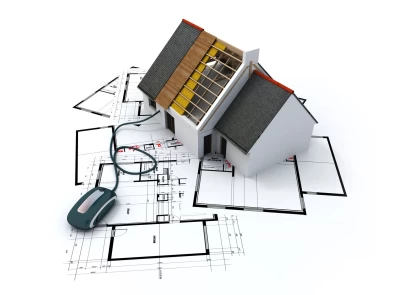Applications of wood in architecture and 7 unexpected benefits you may not know
2 years ago
Some applications of wood in construction architecture
"Wood Industry"
The process of harvesting, processing or manufacturing wood materials will leave behind a large amount of debris, these debris can be processed into many different types of artificial boards which can be used for many different purposes and categories, some commonly known types include:
Plywood: is a type of board made from many thinner layers of wood, with a thickness of 0.3mm-0.6mm and usually not exceeding 3mm, and is tightly bonded together with specialized glue. Plywood is the application of wood in housing projects such as partitions, ceilings, doors, and various furniture and decorations.
Fiberboard is the finished product of processing chips, chips or ground powder of wood and other plants, combining with some plastic materials and hot pressing them together. Fiberboard has good soundproofing and thermal insulation properties and has a thickness of 12-25mm, used for flooring, ceilings, etc.
Plywood is made up of 3 layers, the top and bottom are plywood, the core layer is made from wood chips or powder. All are glued together with a specialized compound into sheets. Due to its color characteristics, laminated wood is one of the popular applications of wood, widely used in interior decoration materials.
Civil sector
In civil works, the application of wood appears a lot in interior design, household appliances such as tables, chairs, beds, stairs, etc.., giving the project a natural beauty, creating a feeling of warm and close. In addition, wood is also used as pillars and formwork in the early stages of construction, as well as other items such as sunshades, floors, pool floors, doors, windows, etc.
Industrial sector
Wood brings certain benefits in commercial projects such as homestays, prefabricated houses, warehouses, restaurants, etc. because of its convenience and compactness. In addition, wood also has good thermal and electrical insulating properties, is environmentally friendly and easy to transport, so it is often used in isolated buildings and used to make furniture and household appliances such as tables, chairs, beds, etc. etc., creating a feeling of warmth and closeness.
In addition, wood is also used for columns and formwork in the early stages of construction and other items such as sunshades, floors, doors, windows, etc.
Advantages and disadvantages in wood applications:
Advantage
1. Has high aesthetic value.
2. High durability and good bearing capacity.
3. Good waterproofing.
3. Suitable for many different design styles.
4. Looks rustic and cozy.
5. Easy to shape.
Disadvantage
1. High price for natural woods.
2. Unable to meet high demand.
3. Easily affected by the weather.
4. Vulnerable to damage by insects such as termites, weevils, etc.
7 benefits of wood in architecture that you may not know
It is a good insulating material and saves energy
Some common construction materials such as iron and steel. concrete, brick, etc. can expand when heated which weakens and breaks the original structure causing the structure to become deformed. Wood reacts in an almost opposite way, when heated by the weather (of course not to flammable temperatures), it becomes drier and harder than at normal temperatures.
If you want to stay warm in the winter (or cool in the summer) and you also want to save on heating (or cooling), wood is a great choice
Maybe you don't know about the application of wood in heat resistance: Wood actually expands a little when air humidity drops below 0%, but this will not affect construction projects because immediately even in the most arid climates, humidity does not fall below 5%.
Economical and convenient during construction
Some units assembling prefabricated houses from wooden materials can complete a 100m² wooden house on site within 7 days. When compared to brick, stone or concrete, wooden constructions certainly save time and it also means labor savings. This is clearly shown when comparing two teams of workers using concrete and wood to build the same project, when there is heavy rain or harsh climate in high mountain areas, the team of workers using wood materials can continue without hindrance. Wood-framed houses will allow investors to make modifications during and after construction, because the ease, flexibility and cost-effectiveness have made it a popular choice and less expensive.
Constructions that use wood are more sustainable, renewable and environmentally friendly. Even once logged, wooden structures still absorb and store CO2. In our country, there are regulations related to natural wood exploitation. This is very important because it will ensure that the number of trees planted will be greater than the number of trees exploited. Mature trees absorb less CO2 than growing trees, which will be beneficial in the global fight against climate change when more trees are planted.
Wooden materials are very friendly to nature
Maybe you don't know about the environmental friendliness of wood applications: 0.8 tons of CO2 are absorbed per cubic meter of wood used in construction, so if a house uses 20 meters wooden blocks save 16 tons of CO2, equivalent to the emissions created when driving 90,000 km. Using wood in construction even if it is a wood-framed building, actually has a positive impact on climate change.
High aesthetics
There are many different types of wood for use in architecture, some types of wood are suitable for heat insulation, others have good sound insulation, the colors and shapes of some other types will be suitable for making frame structures, walls, floors, ceilings and furniture. The grain lines on wood are a masterpiece of nature, possessing the most enchanting, mysterious beauty in the natural world, where different shades of color and texture roll together like a dance.
Wood can be painted in any color, can be waxed and varnished to enhance its natural beauty, in addition, the versatility of wood is shown by being able to be carved, cut, glued, etc. Wood is very versatile and aesthetically, its only limit is the architect's imagination.
Safe, lightweight, sturdy and durable
One of the many reasons why wood is still used today, despite the increasing availability of new construction material, groundbreaking building materials, is its durability, safety and versatility. Wood can be bent, this is a property that bricks do not have, so when there is a force from the foundation, a wooden house can bend instead of cracking like when using regular bricks. Furthermore, structures made from concrete and bricks can cause subsidence and are not suitable for construction in areas with weak soil and difficult terrain.
Soundproofing ability
Although wood does not used as a perfect soundproofing material, wood-based materials help prevent echoes by absorbing sound waves. When compared with other materials, its thermal insulation becomes a special feature beside its soundproofing ability, the soundproofing properties of wood are also used in many concert halls around the world as it naturally dampens sound, creating the perfect tone in the room.
Wood does not rust
Last but not least, wood does not rust, although it can be oxidized in some form, but it cannot be compared. In fact, there are some metals that do not rust, but they are quite expensive, as long as you can protect the wood from insect damage (a variety of paints or glues can be used), the wood is finished can endure the test of time.
 Why should you survey the site before designing?
Why should you survey the site before designing?
Building a project involves many factors even starting from the conceptual design stage, we must clearly understand the current status of the construction land area through site surveys, from there, it serves as a basis for objectively assessing the current conditions of the site and planning to resolve any potential problems that may arise. This is a mandatory step in any project, especially large projects such as schools, office buildings, shopping centers, etc., it will help you save time and money.
 4 rules and basic knowledge about construction architecture you need to know
4 rules and basic knowledge about construction architecture you need to know
Basic knowledge of construction architecture will help you avoid risks that arise during the process of completing the design, understand what the design unit presents and have a basis to refute if there are any unreasonableness in the design.
Accompany us











